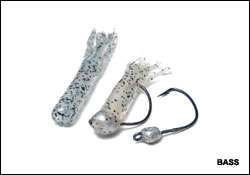
Lone Star angler Cody Bird, a former Bassmaster Tour competitor, refined his considerable sight fishing skills in the clear waters of Possum Kingdom Lake in north central Texas. Here, bedding bass demand finesse baits and don't tolerate aggressive fishermen.
Bird's success with these temperamental fish didn't come easy. He experimented with a variety of baits and found that slender 3- to 3 1/2-inch tubes evoked the most favorable responses. The tubes proved to be even more effective when Bird trimmed the tentacles down to 3/8 to 1/2 inch in length.
"The smaller you make the profile of the bait, the quicker bass will bite it," Bird says. "A trimmed tube is not as intimidating as a bigger bait."
Bird also determined that Possum Kingdom's bass didn't like the look of tubes rigged with bullet weights. Tubes matched with internal jigs were an improvement, but the bass were leery of the exposed hook, which had the additional drawback of being prone to snagging. After testing a variety of hooks, riggings and weight combinations, Bird finally came up with a novel setup that Possum Kingdom's bass really go for, as well as bass across the country.
BIRD'S TUBE RIG
The heart of Bird's tube rig is a 3/0 Kahle hook. He often uses a Shaw Grigsby High Performance hook after removing the wire clip at the hook's eye. Bird crimps a 1/32- to 1/4-ounce split shot to the hook directly behind the eye and fixes it in place with epoxy to prevent it from sliding down the shank. A 1/8-ounce shot is his workhorse. (Split shot comes in sizes and not weights, and Bird estimates the weight of the shot.
Instead of pushing the hook's point through the head of the tube in the regular fashion, Bird slides the hook into the open, tail end of the tube. When the point threads to within 1/4 inch of the tube's head, he pokes it through the side of the bait.
Then Bird pulls the hook through the hole until the split shot snugs up against the inside of the tube. When he swings the hook's bend toward the tube's tail, the hook's eye flops over toward the head of the tube. He pushes the eye through the top of the tube's head and ties on his line.
Though Bird sometimes rigs the hook Tex-posed, he usually inserts the point into the hollow end of the tube where it is less visible to bass. Does this rigging hinder the hook set?
"I've been doing that for more than 10 years," Bird says. "When you set the hook, you've got him."
Bird claims he once fished a major tournament on Lake Champlain in which he sight fished throughout the event with the hook hidden in the end of the tube. He landed enough bass to earn a sizable check and claims he never lost a single fish.
"ALMOST LIKE FLY FISHING"
The tube's light weight is also part of its appeal to bass. It sinks slowly into the bed and rests with a lifelike nose-down posture. It responds to the slightest rod twitch. The lively action encourages bites, but it also quickly pulls the tube out of the bed. Bird compensates for the lack of staying time by making multiple, machine-gun pitches to the bed with spinning tackle.
"My tube is in and out of the bed so many times it's almost like fly fishing," Bird says. "I might make 50 casts to one fish, trying to hit that perfect spot every time."
Bird often starts out casting to a bedding bass with heavier lures and tackle, especially when he's casting to a big fish in heavy cover. On many occasions, he has worked a bass for several minutes without luck, only to switch to his light, trimmed tube and catch the fish on his first or second cast.
Bird's trimmed tube came through when he competed in a Bassmaster Tour event in March 2004 at Santee Cooper. He found bass spawning in sparse grassbeds 2 to 4 feet deep in an off-color creek feeding Lake Marion. The bass were so spooky that Bird had to back away after he spotted them and blind cast a trimmed tube with a 1/8-ounce split shot. Bird averaged about 19 pounds per day, which was good enough to garner fourth place and a substantial payday.
"That little bait really helps me," Bird says. "I couldn't get close enough to watch the bass because they would swim off. I had to keep casting to a fish until I felt her bite or until I saw the line move off."
TRIMMED TUBE TACKLE
Given the light weight of Bird's trimmed tubes, only spinning tackle can deliver consistent cast control. He favors a 6-6 heavy action spinning rod from American Rodsmiths. Bird fills the spool of his Mitchell 300X with 10-pound Berkley Vanish Fluorocarbon line when he fishes clear water. In stained water, and when fishing in and around cover, he switches to 50-pound green braided line.
A white tube with black flake did the trick for Bird at Santee Cooper. Wherever he fishes, Bird prefers this and other natural colors, especially various hues of white, green or brown.




